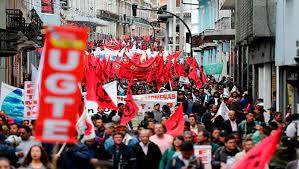While the National Assembly of Ecuador was in session to decide on the repeal of Presidential Decree 455, which established a state of emergency in the provinces of Cotopaxi, Chimborazo and Pichincha, in the centre of the country, the executive itself removed them and issued a new decree, 459, establishing a state of emergency in six provinces of the country. In this way, it deactivated the revocation called by the Assembly, which would have to reconvene to debate this latest decree.
While the Executive and the Legislative are in this “game of rules and procedures”, yesterday, Sunday 19 June, the police force took over the facilities of the Casa de las Culturas de Ecuador, a space that historically and in the mobilisations of October 2019, was a place of humanitarian refuge and support for the demonstrators. The authorities stated that they had received an anonymous call reporting the existence of explosives on the premises of this cultural space. After a search and seizure, as expected, nothing was found but, to this day, the Casa de la Cultura is occupied by the police.
At the same time, the army allowed the passage of trucks and vans with indigenous people and peasants arriving from the south of the country and, disobeying the government’s attempt to prohibit universities from providing humanitarian support to those mobilised, the Central University of Ecuador and the Salesian Polytechnic University, appealing to their autonomy, have officially communicated that they will function as collection and reception centres, especially for women, children and the elderly.
For his part, President Guillermo Lasso issued an official letter to Leonidas Iza, president of the Confederation of Indigenous Nationalities of Ecuador-CONAIE, the main organiser of the mobilisations. In it he describes point by point the responses the government has given and will continue to give to the movement’s demands and reiterates the willingness to dialogue. Paradoxically, it does so at the same time as it deploys military and police forces at the nerve centres of the city of Quito and on the highways that connect with the six provinces included in the decree.
As this article goes to press, there are demonstrations in the centre, south and north of the capital and peasant movements are moving towards Guayaquil, on the Ecuadorian coast.










